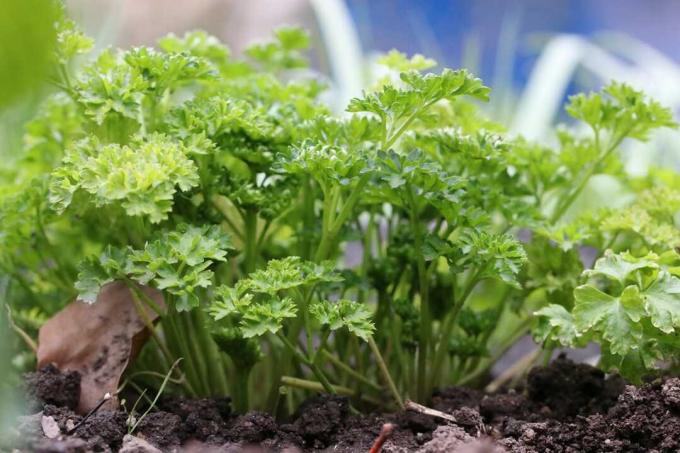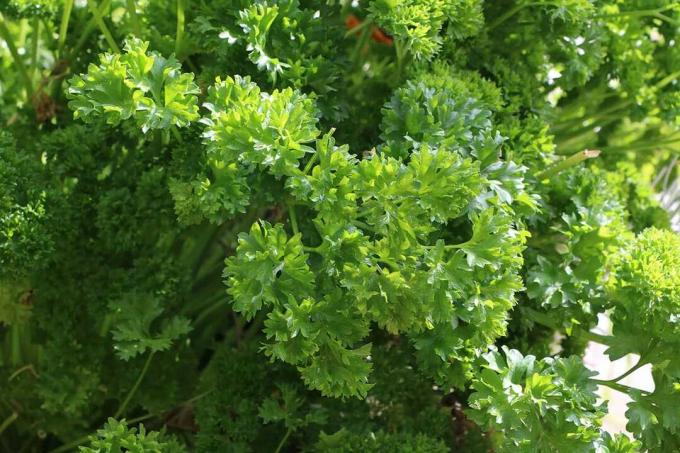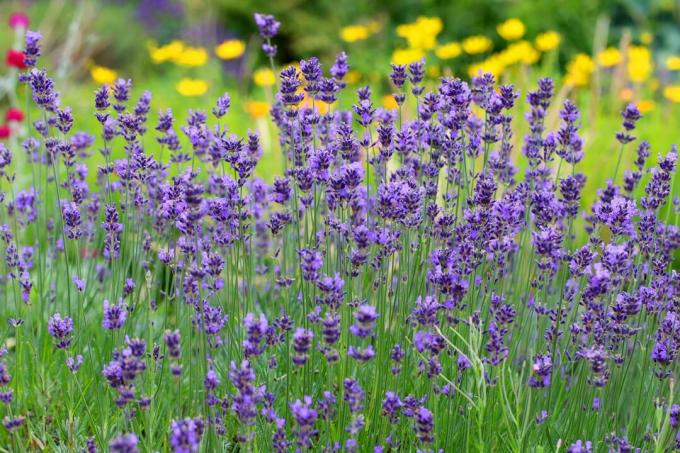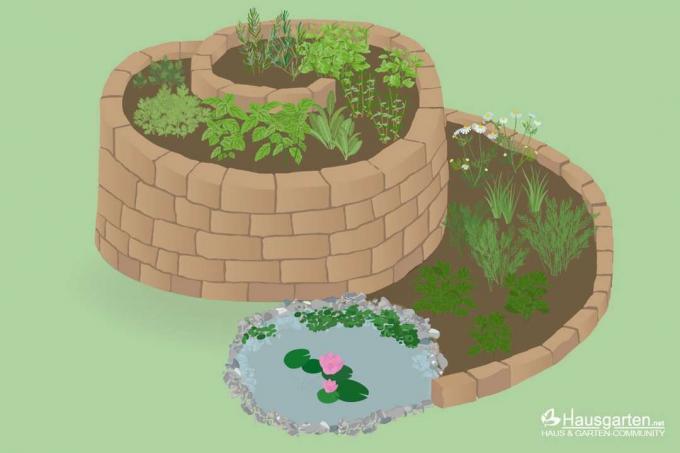

Table of contents
- Best time
- According to the lunar calendar
- Create optimal conditions
- Sowing in the bed
- In the pot
- prick out seedlings
- Collect your own seeds
- Attention poisonous!
This herb is not only very aromatic, but also full of vitamins, minerals and trace elements. One more reason to sow them in your garden or in a pot on the balcony.
Best time
Due to its origin, this herb is a plant that needs warmth, which of course also affects the timing of sowing. The soil should have a temperature of at least eight degrees, otherwise there could be problems with germination. Depending on the weather, these temperatures are reached around March/April. Ideally, the seeds are planted in July/August, when they grow particularly quickly and can be harvested well into autumn.
Since this plant is a biennial herb, it will sprout again next spring. If, despite everything, you decide to sow as early as possible, it is advisable to protect the seed with plastic hoods or sow it in a cold frame. Theoretically, pots can be sown all year round, usually from February to March. In addition, the plants can also be grown in pots and then planted out.
According to the lunar calendar
If you follow the lunar calendar when sowing, the time can be narrowed down a little more precisely. This should have a particularly effective effect on growth. Responsible for this are the forces of the moon, which should not only influence the tides, but also the juices inside the plants. When gardening according to the lunar calendar, this kitchen herb belongs to the group of plants that should be sown on the so-called leaf days.
Tip:
Whether the lunar calendar can actually affect the growth of plants has not been clearly clarified. However, there are empirical values from hobby gardeners, according to which one should definitely try the inclusion of the lunar calendar.
Create optimal conditions
The seeds of Petroselinum crispum germinate poorly, very slowly and unevenly. It can take several weeks before the first seedlings can be seen. But with good preparation, the germination conditions can be significantly improved.
- find the right location first
- if site conditions are poor, germination may fail completely
- Parsley seeds are so-called dark germs
- shortwave light would affect germination
- therefore choose a semi-shady location
- as well as a permeable and humus-rich soil
- Soil should be thoroughly loosened and weeds removed
- Incorporation of some mature compost conducive to germination
- especially in poor soils
- fresh manure would affect germination
- additional support for germination by soaking the seeds
- soak in lukewarm water for several hours
Tip:
Petroselinum crispum belongs to the umbelliferae. This means that it is incompatible with itself and other umbellifers such as dill, fennel or celery, which should be taken into account when sowing.
Sowing in the bed
Once the soil and outside temperatures are appropriate, the soil has been thoroughly loosened, freed from weeds and smoothed, sowing can begin.
- to do this, draw corresponding rows of seeds
- at intervals of 20-30 cm and approx. an inch or two deep
- Mix previously soaked seeds with some sand when sowing
- to prevent the seeds from sticking together
- distribute the seeds thinly in the grooves
- then cover with soil
- so that enough seeds germinate, it is better to create additional rows
- keep soil sufficiently moist for the following four to six weeks
If the soil dries out in the meantime, there is a risk that the seeds will become rotten and can lie in the soil for up to two years until they germinate, or germination will not occur at all. When the young seedlings are big enough, they can be pricked out, both in beds and in pots.
Tip:
Tensioning a line not only straightens the rows of seedlings, it also makes it easy to locate them during the germination phase and remove weeds regularly without causing any damage.
In the pot
For cultivation in pots, seed trays or small pots are filled with sieved, low-nutrient potting soil and pressed down lightly. Spread the parsley seeds on top and cover them again with substrate. The covering layer of substrate should be about an inch thick.

After pressing again, the soil is moistened, ideally using a conventional spray bottle. Now put the whole thing in a warm, not sunny place. The germination temperature should be between 20 and 25 degrees. As soon as the first seedlings can be seen, they can be placed a little cooler.
Tip:
In order to be able to harvest enough leafy greens, you should sow up to ten seeds per pot, more in large pots.
prick out seedlings
In most cases, the fine seeds are sown too densely, so that when the time comes, they have to be singulated. This moment has come when the young plantlets have developed more leaves after the actual cotyledons. Then they are strong enough to be planted in their final location.
Plants sown in spring usually need a little more time until they are big enough to separate. August sowings are a little faster, they germinate faster and can be pricked out earlier. We recommend a distance of about 10 cm between the individual plants and about 20 cm to other vegetable plants.
Tip:
If you want to prevent too dense sowing, so-called marker sowing with radish seeds is a good idea, whereby both are mixed. When the parsley plants start growing, the radishes can already be harvested, thus creating space.
Collect your own seeds
If you don't want to buy seeds, you can easily harvest and sow them from existing parsley. To do this, the plants are allowed to bloom, which by the way only happens in the second year between June and July. When the seeds are ripe, they can simply be plucked off. Then they are left to air dry for a few days. Then they can be sown. Leftover seeds can be stored in a paper bag for next season. Some of them can germinate for up to three years.
Attention poisonous!
Parsley forms poisonous during flowering apiole, an essential oil in high concentration, which can cause health problems. Consequently, they should not be consumed after flowering and pregnant women should also avoid them. In general, this herb should only be consumed in moderation.
 Home editorial office
Home editorial office
Learn more about growing herbs

Basil has black dots: what to do?
Especially basil bought in a pot from the supermarket tends to quickly develop black dots or spots on the leaves. This article explains why this is and what helps against it.

14 kitchen herbs that you can really keep in the kitchen
Sometimes a herb garden is only possible on the windowsill. If you don't have your own garden bed, for example, or in the months when the frost freezes the coveted greenery outside. Our list provides an overview of which herbs like the kitchen location permanently.

Parsley turns yellow: Four tips against yellow leaves
If the leaves of the parsley suddenly turn yellow, the so-called parsley disease is usually behind it. This can have many causes. If the outbreak of the disease is to be prevented, only prevention helps. More about this here.

You can combine lavender with these 13 plants
Whether you use it in the kitchen, want to enjoy its fragrance or its beauty, lavender is a must in any garden. Well combined, it can strengthen other plants or protect them from pests. We present the best plant neighbors.

8 tips for cutting and harvesting herbs properly
Fresh herbs from the garden should not be missing in any kitchen. They are versatile, exude pleasant and spicy scents and are a treat for the eye with their pretty flowers. In the kitchen, they can easily replace artificial flavor enhancers.

Herb spiral & herb snail: this is how it's done
A herb spiral or herb snail makes it possible to plant many different varieties in a particularly decorative way. However, this is not the only advantage of these variants of the culture. You can find out how to create them here.

